Abstract
In TVET training, it is important to build learners’ capabilities of employing engineering principles and concepts from training to solve engineering problems; using knowledge of engineering science to analyse existing conditions and define requirements and constraints related to solving a problem in a complete and accurate statement. Students should be able to develop their knowledge and skills with new or updated engineering tools to solve an engineering problem. Learning how to use engineering knowledge to solve problems may be key to developing a well-trained labour force through TVET in Vietnam. This paper will discuss improving students’ clear thinking and mental efforts to enhance relevant soft skills such as critical thinking, design, recognising and solving problems, quality control and quality assurance through innovation. Engineering design concepts embedded in problem-based learning (PBL) will improve learners’ cognitive actions and assessment, along with simulations of work tasks and processes in classroom activities. Results of practice-based research will be presented in this paper. Online teaching experiences can raise instructor’s awareness in TVET training, and instructional activities can encourage learners to develop self-reliant skills.
This article includes qualitative surveys and quantitative interviews, as well as innovative teaching techniques from previous semesters at UTE. It also introduces some achievements of teaching experiments using problem-based learning (PBL) in strengthening students’ cognitive skills and intellectual habits.
Keywords: problematic situations, PBL, engineering design concept, systematic approach
Introduction
The pandemic has had a big impact on learners and has dramatically changed teaching patterns in TVET. There is a clear shift to learning in the digital world, which necessitates greater autonomy and self-reliance in terms of planning studies. There are some unintended consequences to the pandemic which can be advantageous: lecturers have the chance to change, learners can expand their deep thinking capabilities and develop problem-solving skills independently. The internet opens up big data opportunities to enrich knowledge and skills via digital media.
TVET instructors teach courses in certain professional fields as experts, based on years of study and work – but they are certainly not experts in teaching others about professional fields. They are more concerned with knowledge transfer than unlocking mechanisms to promote student learning, helping them to find ways to accumulate fresh knowledge. How learning processes really work is extremely important to TVET and adult education. TVET educators need to align their instructional methods to the characteristics of students in order to facilitate students’ accumulation of knowledge and skills. Zimmerman notes that students:
(1) can personally improve their ability to learn through selective use of meta cognitive and motivational strategies;
(2) can proactively select, structure, and even create advantageous learning environments; and
(3) can play a significant role in choosing the form and amount of instruction they need. (Zimmerman 2000, 4)
Project-based learning (PBL) is a commonly used technique in Vietnam’s TVET as one of the most popular methods to train hand-on skills, especially in the field of technology. However, qualitative surveys conducted in previous semesters at UTE exposed limitations in implementing PBL. Students had difficulty with the project’s initiative, often skipping relevant steps of the engineering design process such as defining problems or analysing/testing results. Unfamiliarity with engineering design processes proved an obstacle. A systematic approach to the design process would help students to deal with projects more effectively. Otherwise, these limitations hinder students in the project design phase, potentially leading to an unstable or unreliable model. To solve these disadvantages of PBL, engineering design has been broken down into an eight-step design process according to Kosky’s model. Integrated into PBL, this strategic approach would support students in thought processes for design. In addition, teaching techniques would be enhanced by focusing on the mechanism of neural connections and the conditions of organised learning processes so that students can utilise prior knowledge in new situations or problems. This would be useful preparation for the world of work, so that students can take on responsible roles on their entry into professional practice and meet the high demands of industry 4.0.
2. Learning theories as foundation for innovation to support students’ cognitive strength and improve learners’ intellectual habits
Ambrose et al. (2010) have emphasised that effective teaching must begin with a consideration of how students learn.
“Learning is not something done to students, but rather something students themselves do. It is the direct result of how students interpret and respond to their experiences — conscious and unconscious, past and present” (ibid., 3).
Learning is an intellectual process in which knowledge should be consistent. Students bring their prior knowledge to new courses and may use it systematically to attain new knowledge through their thoughts, feelings, and actions. Nevertheless, prior knowledge can help or hinder future learning processes. If students’ prior knowledge is robust and accurate and activated at the appropriate time, it provides a strong foundation for building new knowledge. If, however, their prior knowledge is inert, insufficient for the task, activated inappropriately, it could prove to be an impediment (ibid., 13). Students make connections between the building blocks of knowledge. Connections are initiated and formed when knowledge is structured and meaningfully organised. Students are better able to retrieve and apply their knowledge effectively and efficiently when instructors adopt a methodological teaching approach. To assist students in mastering essential knowledge and self-reliant learning, they should be asked to apply their prior knowledge to solving a problem or carrying out a practical task. Effective instruction during lessons facilitates students’ knowledge, stimulates particular types of thinking, and motivates students to focus on key aspects of a topic so that they know how to apply what they have learned (Westwood 2009, Ambrose et al. 2010, Schunk 2012, Hoepfner & Koch 2015). Combining and integrating component skills and knowledge to perform complex tasks fluently and automatically is essential for TVET. In addition, pedagogical approaches to teaching must be founded on the neuroscience of learning. TVET instructors and lecturers should pay attention to the relation of the nervous system to learning and behavioural characteristics of knowledge transfer processes in the classroom, which involve using information in novel ways or in new situations: “From a neuroscientific perspective, this means that neural connections are formed between the learning and the new uses and situations. These connections are not made automatically. Students must learn them through experiences (e.g., teaching) or determine them on their own (e.g., through problem solving)” (Schunk 2012, 81). Consequently, problem-based learning (PBL) becomes a standard method in TVET which can engage students in learning and help to motivate them in developing component skills and knowledge. PBL allocates students into work groups so they can improve their cooperative learning skills. Problem-based learning requires students to think creatively, bring their knowledge to bear in unique ways and strengthen cognitive connections as well as triggering neural firing. Transmission of information becomes more rapid and effective. Learning processes are consolidated, described as “the forming and strengthening of neural connections (synapses)” (Schunk 2012, 69). Problem-based learning, therefore, is an effective learning method, based on brain-related educational methods and especially useful for (group) projects. Commonly applied in Vietnamese TVET, project-based learning (PBL) strengthens trainees’ hands-on skills in the technical field, under the banner of work-oriented learning (Schröder & Dehnbostel, 2021). It has been a policy at University of Technology and Education in Ho Chi Minh City since 2012 (HCMUTE 2012), when the first cohort of faculties returned from Arizona State University where they had been trained in the Higher Engineering Education Alliance Program (HEEAP), initiated by Intel. The HEEAP is a breakthrough project of Intel, seen as a solution to solve disadvantages in engineering education exposed through the myth surrounding Intel’s recruitment event: “only 40 engineering graduates passed the Intel recruitment test among 2000 competitors” (The Du et. al 2018, 14) when the company scouted for a qualified workforce to operate its assembly and test manufacturing plants (ATM) in Ho Chi Minh City. This might well be an exaggeration. Intel certainly found it difficult to build a qualified workforce for its new ATM due to a shortage of skilled labour. Intel is by no means an isolated incident. Mori’s research on “Skill Development for Vietnam’s Industrialization: Promotion of Technology Transfer by Partnership between TVET Institutions and FDI Enterprises” also highlights the shortage of skilled labour in Vietnam:
Many enterprises are still seeking: (i) multi-skilled production line leaders who can manage and improve the entire production process rather than remain limited to a specific one; (ii) engineers or technicians who are skilled at high-precision processing in making metal, plastic parts, moulds and dies; and, (iii) middle managers who can lead day-to-day improvement of factory operations by identifying and resolving problems from a broad and long-term perspective (Mori 2009, 5).
Applying PBL at UTE is a breakthrough because students can develop capability of applying past knowledge to good use in new projects. UTE is organised in the form of work-oriented learning: “Learning is made up here of simulation of work organization, work tasks and processes. It sets out to simulate real work places as exactly as possible. As learning rather than work is the primary aim, the disparity of simulated and real work places cannot be compensated” (Schröder & Dehnbostel 2017). Through these hands-on projects, they will be trained in important skills such as teamwork, communication, negotiation, etc. But their activities in conducting projects are still driven spontaneously and depend totally on the lecturer’s instruction and supervision, often through trial and error. There are two key reasons for the lack of convergence between engineering education and engineering practice: (1) an absence of rationale (engineering design concept as guideline for student’s project implementation, and (2) an absence of detail (lecturer’s observation and supervision of students to ascertain if they go through the design process step by step. This should ensure that students’ relevant skills are formed during the course of the project). This can be seen in the analysis of quantitative surveys and qualitative interviews conducted with students.
On the other hand, trainees are still dependent on “knowledge portions given by a teacher, on demonstrations done by a teacher, on the supervision of their activities by a teacher, on assessments of their learning results done by a teacher. They don’t ask a lot, they watch, they listen and they imitate what their teacher does” (Hoepfner & Koch 2015, 11). This is a typical characteristic of Asian culture, where teachers play a central role in the learning process. Furthermore, they cannot reuse their prior knowledge to explain a current situation in which they have a problem to solve. For example, they were asked: “why should we heat steel C45 to the temperature at which transformation from pearlite and ferrite to austenite happens?” in a metallography and materials testing course, having nevertheless already learnt about materials science in the previous semester (according to qualitative recording data in a metallography and materials testing course). In fact, there are no immediate answers which learners can use as professional workers. A decision made by a professional worker comes as a result of deep thinking and a capacity to recombine past knowledge unconsciously. Thorndike has suggested that “drilling students on a specific skill does not help them master it nor does it teach them how to apply the skill in different contexts” (Schunk 2012, 76). Therefore, instructors and lecturers should approach fundamental types of learning which deal with forming associations (connections) between sensory experiences (perceptions of stimuli or events) and neural impulses (responses) that manifest themselves behaviourally when they plan their teaching activities. They must understand mechanisms of information transmission, characteristics of cognitive processes that are represented in the same way that knowledge is represented by synaptic connections in the brain. It is essential to choose teaching techniques that support trainees’ readiness to overcome all of the challenges they might face in future work by producing connectionism between kinds of memories which involve information being established so that neural connections are made and neural transmissions become automatic. It is important to help trainees become capable of recombining past knowledge in decision-making processes, able to sketch out proper solutions for problems in the world of work which is constantly changing at such a rapid pace. Moreover, instructors and lecturers should consider factors that improve consolidation, organisation, rehearsal, elaboration, and emotional involvement in learning such as creating triggers by questioning or putting learners in problematic situations. The various theories of learning include self-regulation (or self-regulated learning), which “refers to processes that learners use to systematically focus their thoughts, feelings, and actions, on the attainment of their goals” (Schunk 2012, 400). Self-directed learning is another theory, in which learners are engaged in a variety of metacognitive processes to monitor and control their learning. Once students develop the skills to engage their learning processes, they can develop intellectual habits that not only improve their performance, but also their effectiveness as learners (Eberly Center n.d.).
Exploring necessary conditions for building a self-reliant learning environment through experiences in teaching at UTE.
It is necessary to build an environment of self-reliant learning in which students are encouraged to create links between past knowledge which they can accumulate by solving more or less complex practical or theoretical problems. Through these actions, learners become active, they have to perform and take responsibility for their actions. Using concepts of engineering design as guidelines for student projects should empower students’ thinking and lay solid foundations for thought processes.
“Learning in school-organized teacher-student arrangements at institutionalized venues requires the focussed development of reflexive action competence. This reflexive action competence describes the ability to reflect on the structures and organizational forms of work as well as on one’s own actions in the work-process in the phases of preparation, performance and evaluation” (Roth et al. 2021, 2).
The following section will discuss which learning activities are designed to encourage students to recover their past knowledge to deal with processing their projects.
3.1 Integrating engineering design concepts as a guideline to implementing student projects in PBL.
The first question is: what lead students in processing their project? Short qualitative interviews were conducted in which students were asked to use a word to describe engineering design processes at the beginning of their courses. Their answers indicate that students consider engineering design as more of an action, like technical drawings, rather than a process. To understand better how students deal with their projects, a further quantitative survey was implemented, in which students were requested to answer questions on the topic of “engineering design”. The questionnaire comprised the following questions:
- What is engineering design really?
- What is the outcome of engineering design?
- Which step do you usually skip when you conduct your project?
- Which step is the most important in the engineering design process from your point of view?
The students’ responses reveal that they see engineering design as an activity rather than a process. They tend to finish projects when asked to do so by their lecturers, but their focus is simply on getting a project done, which makes them liable to neglect controlling or testing their project models properly. Although they recognise that testing or controlling models in operation is a vital step of design, their projects are often incomplete (Figure 1).
It is very interesting to note that 39 per cent of students are likely to skip the first step of the process. Responses to the first question illustrate that students need to develop logical thinking habits to appreciate design concepts more clearly. On the other hand, students believe that they should focus on important steps such as testing and evaluation of performance rather than defining the problem and collecting information about the object of research. This is a positive point to emerge from the research. However, students also show that they have no idea how to manage testing activities when they operate on the principle of trial and error. The essence of engineering design is, in fact, how to recognise and solve problems which can arise during project implementation. Instructors need to guide students to follow the pattern: conceive-design-implement-operate in order to make them understand that design in engineering is really a process.
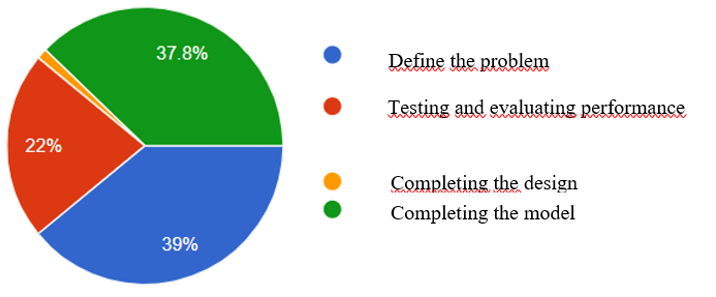
Engineering design is actually a loop with specific process alignment – not a linear process. Students should be tutored to adopt a systematic and logical approach to engineering design in order to strengthen their thought processes in project work. Through this action, students can learn how to gather information mentally from external sources. A design process flowchart, as depicted in Figure 2, will guide them step by step in specific project planning. Project implementation will be carried out in practice once the plan has been adjudged to be appropriate. At the end of the design loop, students can compare results with the defined outcomes as described in the rubric (see Figure 3) which has been prepared to assess the project’s result. Comparing operation results at each step during project implementation clarifies whether or not it is necessary to change individual steps or the whole plan.
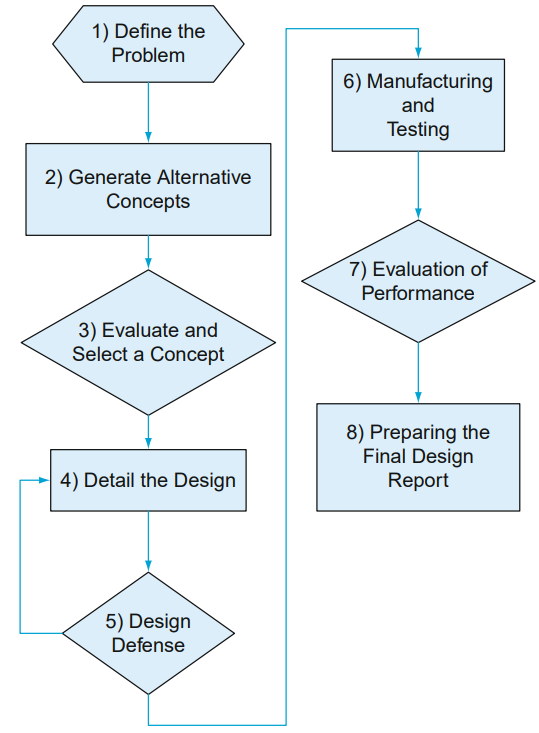
An embedded didactical approach to engineering design processes in PBL will help to prepare students for the world of work. Design skills are essential for engineers in the era of technology. According to Mori, engineers (or skilled workers) “… should be considered production engineers who lead the improvement of factory layout, jigs, person-hours, and in-house logistics flows in close cooperation with the production and design departments of an enterprise’s headquarters” (Mori 2009, 5). They should do “the job of engineers to be able to engineer”: The conceive-design-implement-operate sequence can add value to engineering products, processes and systems in a modern, team-based environment (Crawley et. al 2014, 50). Engaging students in assessment using a clearly defined rubric (Figure 3) will help students to build self-reliance with regard to quality assurance.
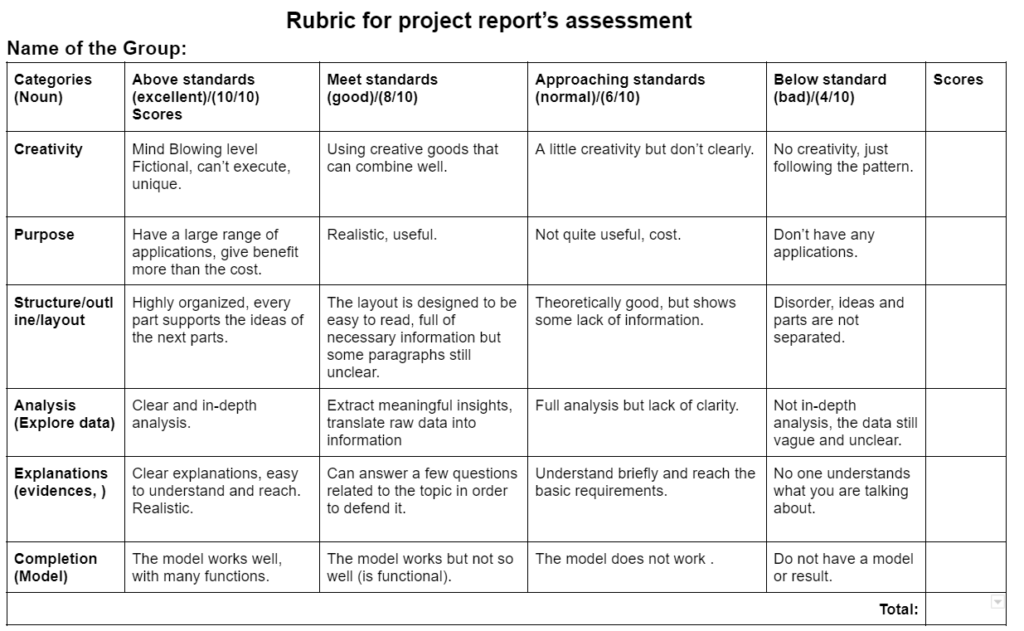
3.2 Strengthen students’ cognitive activities by teaching techniques to link past knowledge with the execution of designed action structures in solving problematic situations.
The world of work is in constant flux and technology can create uncertainty when lifelong learning skills are required. Trainees may pick up knowledge in school, which is obsolete by the time they graduate. Teaching foundational knowledge and technical basics should, therefore enable engineers to think logically and develop calculations to work on practical problems. When ideas become reality, useful products and projects can be manufactured and constructed. Conveying engineering design concepts to students is one example of this. A successful instructional process in TVET is one in which learners can recall knowledge or use external information to implement their project or manufacturing process in future work. They should learn how to use past knowledge and collect the information they need to solve specific problems. This is known as action competence, which is of interest to potential employers. In case of metallography and materials testing courses, students are asked about the temperature of heated work pieces based on colour, but without referring to a colour chart. Their responses ranged from 700 until 1600 centigrade. They are then asked to estimate temperatures with a colour chart (Figure 4), which leads to more precise results.
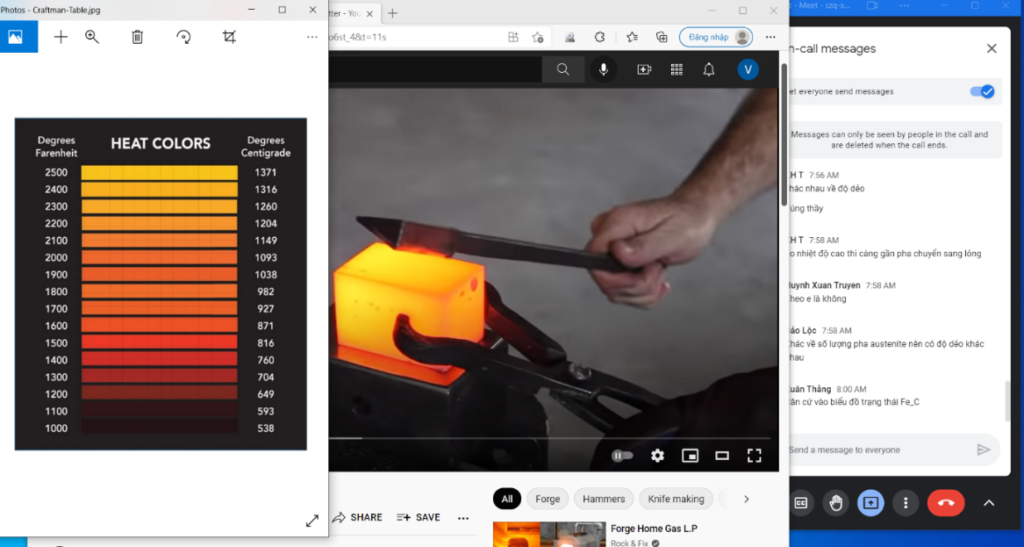
Students are asked to explain why the work piece needs to be heated up to the temperature at which it is most ductile (and easier to form). The question is designed to determine if students are able to draw on past knowledge from courses such as materials science in order to give their answer. Previous results were overwhelmingly negative as students were unable to explain adequately without reference to an iron carbon phase diagram depicting austenite. (Fig. 5) Here, they could see the ductile properties of a face-centered cubic lattice which is more pliable than, for example, a body-centered cubic structure. Bridging past knowledge of austenite from a previous course to determine ideal heating temperatures for optimal ductility is a didactical approach which features a problematic situation for students to solve through knowledge of engineering sciences. This approach will develop students’ awareness of professional practice capabilities in work processes where engineers must find solutions.
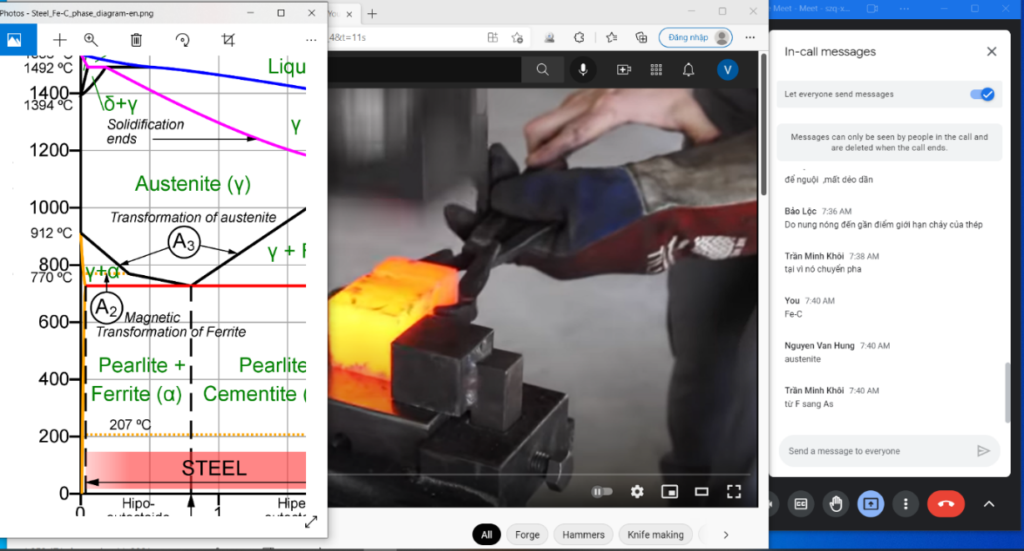
This action help students to understand how to recall and use unconscious knowledge to arrive at an explanation or solution for a certain problem. It enhance students’ cognitive activities by creating a mutually cognitive environment (Ritchie 2004) in which learning processes support the development of students’ habitual capability to recall and use their learning background to solve problems.
4. Results and Remarks
Embedding design thought processes as a loop according to Kosky’s model makes sense when it helps students to solve problems more effectively. The eight steps design process plays a role as cognitive structures and design process simulations (similar to the manufacturing environment) can provide students with a road map for practice in the context of project design. A didactical approach to design thought processes ties in with hands-on experience in learning how to develop a product, process, or system. For example, one design project – the smart dustbin – from a previous semester was not completed as the students did not conduct any tests on the model. They had not yet mastered engineering design. The team has been now requested to improve their project by focusing on testing and analysis. They were also asked to come up with tests for their model in different conditions and then analyse the results. They set up four working conditions to test the model (Table 1). Running tests meant that the team could subsequently modify the design. Finally, they were able to choose the most appropriate concept for their project. The testing phase added stability and reliability to the smart bin operation.
| Prototype | Working conditions | Analyze the result |
| 1 | – Setting prior detection range of the first sensor at 380 mm when totally empty and 100 mm when full. The remaining space is divided into 4 levels. – Setting the maximum detection range of the second sensor at project 250mm. – Setting the delay for users to put trash in the bin at 3 seconds. – LEDs displays in 4 different colours to show the remaining space. – Notifications and email alerts will be sent continuously. – Setting the opening angle of the servo motor at 50°. | – The bin could not open although it is full (didn’t have enough space for the lid to rotate). – The lid still opening in full condition. – The lid also opened accidentally (need to be optimised). – The lid closes too quickly (causes difficulty for users). – The bin was still working when cleaning (risk of components being damaged). – Annoying users with notifications and emails. |
| 2 | – Changing the detection range when full to 140 mm. – Changing the program to force the lid to close when full. – Increasing the delay to 5 seconds. | – The bin was working more stably. – The lid still closes too fast. – Some issues still could not be solved. |
| 3 | – Increasing the remaining space levels to 8. – Updating to increase LEDs colour indicators to 8. – Adding LEDs display patterns to alert when a second person is detected in range and when they move away. – Updating program to set gap between push notifications and emails to 15 minutes | – The bin was working more stably and more accurately. – The lid still closes too fast. – The alert period was better. – Some issues still could not be solved. |
| 4 | – Updating program to remove delays and now keeping the lid open until users move away. – Updating program to stop the bin from working when the user is cleaning it. – Adding a ‘do not disturb’ mode to stop push notifications and emails to prevent annoying users. – Adding the slider to change the brightness of LEDs to reduce power consumption. – Changing the opening angle of the servo motor to 60°. | – The bin is now working effectively, stably and accurately. – The lid opening angle is more suitable for the user. – All issues are solved. |
Furthermore, students in other groups were also required to focus on the step of analysing the pilot model’s performance according to Kosky’s model in the context of design guidance. They finished successful projects such as: automatic hand washer, chess-playing Scara-robot, Seabin (bin to collect rubbish on ocean surface) which were both stable and reliable. It is important for students to decide on testing plans and conditions in which a model should run smoothly and perfectly. On completing this step, they can select more suitable concepts for projects. Converting ideas into design models as per Kosky can support students in simulating real design procedures in which they apply their knowledge and develop professional engineering practising skills. It is really useful to help students transition from novices to experts in technology design.
Design concepts can give students roadmaps to lead them through design processes from start to finish without skipping any important steps throughout the project, especially if they can build specific testing conditions with goals in mind. Breaking these down into sub-goals and creating a rough plan in their mind before they begin will lead to more coherent action steps. Embedded engineering design concepts in PBL can create a correlation between thought processes and practical action. What starts in the mind will encourage correct actions. An engineering design concept in this context is a means to help student set clear goals when implementing their projects. It connects action, action structure and action competency. The “building of fire and gas warning models using Arduino” project (Figure 6) creates a context in which students can learn how to design and construct a model and its electrical circuits to fulfil requirements of the project, accumulate their past knowledge of electronic components from previous course modules and choose fitting component parameters which can be linked together. Most of all, they can learn how to develop genuine situation issues (fire and gas warnings) and appropriate solutions (the model with gas and temperature sensors). To finish the project, they have to research how to operate Arduino IDE in order to program it. Programming Arduino will push them to learn coding with C language programming and learn how to communicate between hardware and software. Based on the engineering design concept of Kosky, students can define key factual information in one or more applicable areas of engineering science as related to their project. They have the chance to use knowledge in one or more areas of engineering science to improve elements of a project or product and learn how to employ principles and concepts of engineering science to solve engineering problems. Working in teams improves collaborative skills and encourages the application of critical thinking skills in their project. At the end of a project, they can identify and understand types of experiments conducted by engineers for specific applications. They can design an experiment to test a hypothesis, such as the potential effectiveness of a proposed solution to an engineering problem. This acquaints them with analysis and interpretation of results, helping them to develop a recommended plan of action based, to a degree, on the results of their experiments.
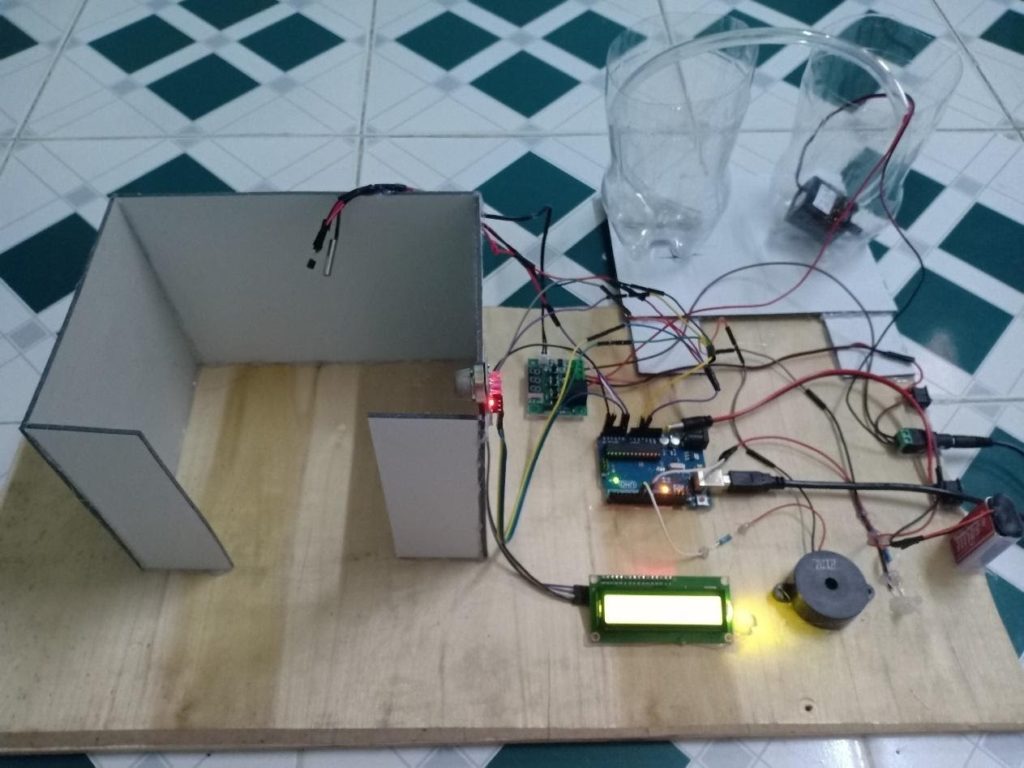
In the case of creating problematic situations in learning processes, student’s inferences are always based on assumptions and guesses or opinions formed on the basis of existing knowledge or the information that they have – for example, they can compare colours of heating work pieces with a colour chart to calculate temperatures accurately. When asked: “why should we heat steel C45 to the temperature at which transformation from pearlite and ferrite to austenite happens?” they have already learned how to combine prior knowledge and make the connection to basic information as they respond. For example, students can estimate the temperature of a piece of metal with a degree of accuracy by referring to a colour chart and give an appropriate answer regarding the quenching process in the next action. Students now have the intellectual habit of expressing an opinion or answer for a question arising out of a problematic situation. They can follow logical cognitive steps connected to their foundational knowledge in order to find out a suitable answer or expression. In TVET training, individual interpretations in learning processes and, later, in working processes should be considered as representations of common ground – the basic foundation of professional training and linked to long-life learning skills of students.
5. Conclusions
In TVET Vietnam, there is still a debate on how engineering science should be transferred effectively, how knowledge should be compacted in relative fields such as the Lernfeld (learning field) concept, similar to the German model, or split into separate subjects in certain engineering fields, which can assists learners in the development of professional skills. Unfortunately, training curricula in TVET Vietnam are normally designed as collections of separate courses for various topics in relative engineering fields such as materials science, manufacturing technology, metal processing technology, electronic components etc. As a consequence, students cannot connect knowledge from individual courses (if not requested to do so). Building students habitual reactions to use past knowledge to solve present problematic situations is essential if students are to be capable of connecting engineering science and engineering tools to overcome challenges at the workplace in future. Engineers who are ready to use foundational professional knowledge and capabilities in work can draw on appropriate knowledge and choose the right tools to solve engineering problems; they can recombine knowledge in one or more areas of engineering science to meet the needs of a new project or production; they can employ principles and concepts from one or more areas of engineering science to create a new engineering concept in the solution of an engineering problem. Therefore, it is necessary that all courses in a certain training programme are carefully organised and taught in a logical sequence, in which knowledge is linked and clearly transferred in relation to specific professions. Furthermore, teaching techniques should be built on proper learning theories and neural science. Instructors or lecturers must have a suitable methodological approach to teaching which will motivate students’ mastery of essential knowledge and self-reliant learning. Appropriate pedagogical activities in students’ learning processes can provide a strong foundation for building new knowledge and makes students’ prior knowledge more robust, as well as catalysing the acquisition of new knowledge. Learning is an intellectual process in which knowledge should be consistent and meaningful connections between prior and brand new or fresh knowledge are initiated in a structured manner. Using questions or requesting students to apply prior knowledge to solve a problem, or to practise a task during PBL in order to facilitate students’ knowledge and stimulate particular types of thinking are key aspects in terms of strengthening students’ cognitive activity. Neural connections are formed between learning and new uses in new situations, so students must learn through experience under instructional processes or through their own problem-solving actions, as Schunk says. These innovations will build an education ecosystem in TVET training based on the principle of supporting engineers’ work readiness and providing a solution to alleviate the skilled worker shortage, delivering workers who are capable of facing any challenge at the workplace.
References
Ambrose, S. A., Bridges, M. W., DiPietro, M., Lovett, M.C., & Norman, M. K. (2010). How Learning works: Seven Research-Based Principles for Smart Teaching. 1st Edition. San Francisco, United States of America: Jossey-Bass Inc.
Crawley, E. F., Östlund, S., & Edström, K. (2014). Rethinking Engineering Education: The CDIO Approach, 2nd Edition. Basel: Springer International Publishing Switzerland.
Dehnbostel, P. & Schröder, T. (2017). Work-based and Work-related Learning –Models and Learning Concepts, In: TVET@Asia, 9, 1-16. Online: http://www.tvet@online.asia/issue9/dehnbostel_schroeder_tvet9.pdf (retrieved 30.06.2017).
Eberly Center. (n.d.). Learning Principles: Theory and Research-based Principles of Learning. Pittsburgh: Carnegie Mellon University. Online: https://www.cmu.edu/teaching/principles/learning.html (retrieved 15.01.2022).
Hoepfner, H. D. & Koch, H. (2015). Self-reliant Learning in Technical Education and Vocational Training (TEVT). In: Paryono, P., Schröder, T. & Spöttl, G. (eds.): RAVTE Practice and Working Paper. Online: https://tvet-online.asia/wp-content/uploads/2020/03/PWP_vol-4_Hoepfner_Koch.pdf (retrieved 30.06.2020).
Kosky, P., Wise, G., Balmer, R., & Keat, W. (2010). Exploring Engineering: An Introduction to Engineering and Design, 2nd Edition. Amsterdam: Academic Press, Elsevier.
Rigoni Ironworks. (2021). Blacksmithing Tools: Flatter. Online: https://www.youtube.com/watch?v=tSUs7o6st_4 (retrieved 30.06.2020).
Ritchie, D. (2004). Metaphors in Conversational Context: Toward a Connectivity Theory of Metaphor Interpretation. In: Metaphor and Symbol, 19, 265-287. Online: http://web.pdx.edu/~cgrd/Connectivity%20Theory.html (retrieved 30.11.2021).
Roth, Y.-L., Schulte, S., & Spöttl, G. (2021). Perspectives and Criteria for Supporting Holistic Competence Development in Work-Processes. In: TVET@Asia, 17, 1-24. Online: http://tvet@online.asia/issue/17-1/perspectives-and-criteria-for-supporting-holistic-competence-development-in-work-processes/ (retrieved 31.07.2021).
Schunk, D. H. (2012). Learning Theories: An Educational Perspective, 6th Edition. Boston: Pearson.
Schröder, T. & Dehnbostel, P. (2021). The workplace as a place of learning in times of digital transformation – models of work-related and work-based learning and in-company concepts. In: TVET@Asia, 17, 1-16. Online: https://tvet-online.asia/issue/17-1/the-workplace-as-a-place-of-learning-in-times-of-digital-transformation-models-of-work-related-and-work-based-learning-and-in-company-concepts/ (retrieved 31.07.2021).
The Du, H., Trung Dung, H., Xuan Thanh, Ng, & Anh Tuan, D. Th. (2018). Intel products Vietnam 10-year investment: impact study report 2006-2016. Ho Chi Minh City: Fulbright University Vietnam. Online: https://fsppm.fulbright.edu.vn/en/policy-papers/policy-research/intel-products-vietnam-10-year-investment-impact-study-report-2006-2016/ (retrieved 04.02.2022).
University of Technology and Education Ho Chi Minh City (HCMUTE). (2012). Regular Nr. 117 regarding Innovation of teaching and learning activities at HCMUTE. Ho Chi Minh City: HCMUTE.
Westwood, P. (2008). What teachers need to know about Teaching methods. Australia: ACER Press.
Zimmerman, B. J. & Schunk, D. H. (1989). Self-Regulated Learning and Academic Achievement: Theory, Research, and Practice. New York: Springer Verlag.
CITATION:
Vo, X. T. (2022). Problem-based Learning (PBL) with embedded design concept to strengthen students’ cognitive activities. In: TVET@Asia, issue 18, 1-16. Online: https://tvet-online.asia/issue/18/problem-based-learning-pbl-with-embedded-design-concept-to-strengthen-students-cognitive-activities/ (retrieved 31.07.2021).


